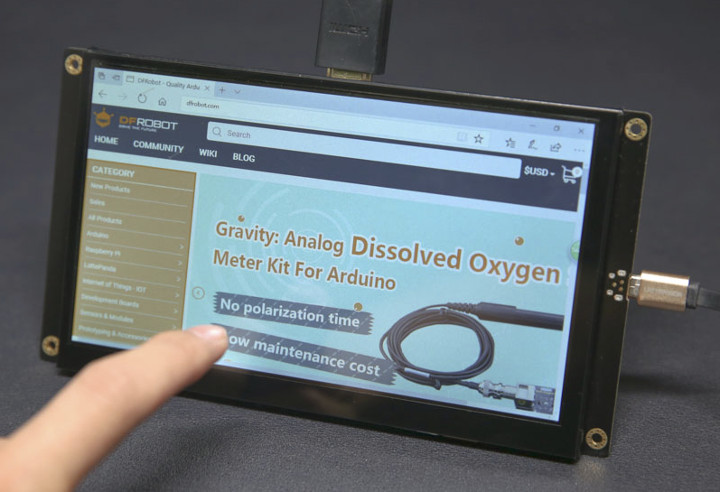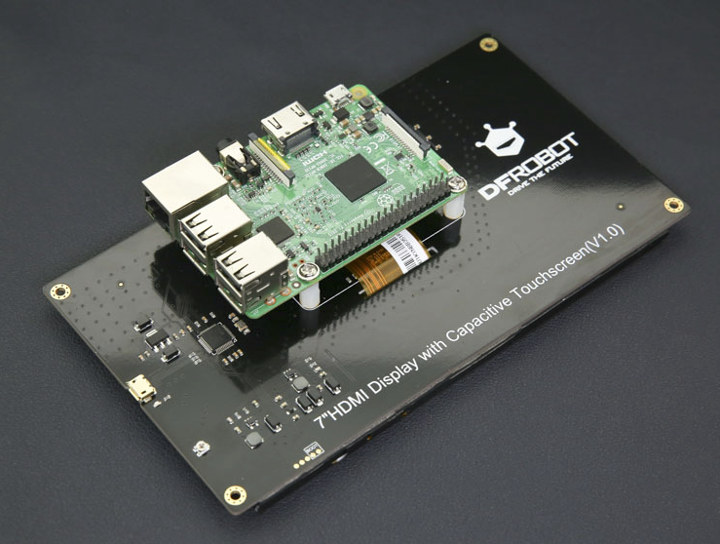There are plenty of HDMI displays, but if you want a smaller size it become more complicated although some 7″ HDMI displays are available.
However, if you want to add touchscreen support, then the choice becomes even more scarce, especially if you want a neatly packaged solution. That’s why DFRobot’s 7″ HDMI display with a 5-point touchscreen may be interesting, and as a bonus it also features mounting holes for Arduino & Raspberry Pi boards.
Specifications:
- Display – 7″ display with 1024×600 resolution @ 43 Hz (60Hz is possible, but not recommended as it will not be full screen)
- Interfaces – HDMI input for video, micro USB port for touchscreen
- Voltage & current – 5V @ 160 mA with HDMI connection (1.2A max)
- Dimensions – 183 x 100mm; mounting hole size: 3.1 x 6mm
- Weight – 328g
Despite the 1.2A maximum current, the company claims an external power supply is not needed for the display, and one can simply use a USB port from the host computer, board, or device. However, they recommend a 5V/1.5A power supply when the display is driven by a Raspberry Pi boards, as a lower current will reduce touching sensitivity.

No drivers are needed for operating, but you may still need to install some USB tools if you plan to update the firmware, and Raspberry Pi board must be configured in a specific way as explained in the Wiki.
If you are interested, the 7″ HDMI display with capacitive touch is sold for $69 plus shipping. DFRobot is not the only company with such solution, as Adafruit offers 5″ and 7″ models, and Lilipu Direct sells more expensive models with full enclosure.
All those work but I find the HDMI + micro USB solution to be suboptimal for devices with a USB type C port whose cable could carry both video and data, so a single cable would be needed. I could find some touchscreen displays with a USB type C port, but they apparently don’t use it for video signal, only USB (touchscreen) data. So either my Web search-Fu let me down, or we simply need to wait a little longer for USB type C touchscreen displays…

Jean-Luc started CNX Software in 2010 as a part-time endeavor, before quitting his job as a software engineering manager, and starting to write daily news, and reviews full time later in 2011.
Support CNX Software! Donate via cryptocurrencies, become a Patron on Patreon, or purchase goods on Amazon or Aliexpress





Would love to see a tablet motherboard replaced with an HDMI+LCD controller, with USB-C connector. Could benefit from economies of scale by approaching the OEM(s) to purchase housing and LCD/touchscreen assembly. Only potential oddity would be the front camera aperture from the original tablet. But sufficient volume would allow for that to be covered up during manufacturing.
You could even use the existing headphone jack to allow analogue audio out, or use the original tablet speakers, etc, etc.
By removing the battery, you could make space for mounting hardware (VESA, etc).
As an aside, is it possible to have a dual-mode cable with an HDMI *and* USB-A connector on one side, and USB-C connector on the other side, that will allow an arbitrary HDMI capable device to send video to a display with a USB-C connector, while powering the display via USB2 (and potentially accessing the touch screen data)? Everything I have found so far seems to assume the other direction is more preferable, allowing newer USB-C capable devices to send video to an older HDMI display. I suspect the answer may be no, because enabling USB-C Alternate modes requires negotiating… Read more »
Alternatively, completing the DisplayLink kernel device emulator driver here (https://github.com/kopasiak/f_dl_ffs) would allow arbitrary Linux tablets to enable a DisplayLink mode, with suitable host-side drivers. And of course, expose the touch screen via a standard HID interface.
a bit more expensive, but you get 1080p in 6″: https://www.kickstarter.com/projects/1924187374/manga-screen-2
Nice one ($99). I actually wrote about that one a while back. It’s so hard to keep up with everything, and Manga screen 2 did not show up at all in my web searches.
Friendlyelec display for their T4 claims open source drivers but is eDP. Would that be any use CNX?
That’s useful as long as you have an eDP connector on the host board too. Most devices don’t have this.
I don’t know for sure, but it looks like the LS059T1SX01 LCD that’s easily available from China: https://www.aliexpress.com/item/5-9-inch-Transflective-Full-HD-1080-1920-1080p-LCD-screen-display-with-HDMI-to/32829608445.html
Wonder if they’ve cobbled together their own driver board, or use the Toshiba(?) mipi hdmi circuit? In any case $99 sounds pretty good, even though it could have used a real enclosure.
Now any USB type C to HDMI “cable” would need to have a DisplayPort to HDMI converter, but this made me remember HDMI Alternative mode over USB type C is in the works, and soon enough we should start to see USB type C to HDMI cable without any requirements for conversion.
https://www.cnx-software.com/2017/06/29/usb-type-c-to-hdmi-cables-coming-soon-thanks-to-hdmi-alt-mode-for-usb-type-c/
That was announced one year ago, but I don’t seem to find such cables.
Yes, but I suspect that that article is talking about a content producer with a USB-C port, delivering that content to a display with an HDMI port. I was talking about the other direction: A content producer with an HDMI port delivering content to a display with a USB-C port. Given the growing number of monitors with USB-C ports, this will likely become more of an issue in the future, but as mentioned above, I suspect it will be a problem because an HDMI port has no knowledge of the negotiations required to enable USB-C Alt Mode. Unless the smarts… Read more »
Or you could find a display that uses eDP like many of laptop displays these days. That would remove the need for heavy conversion. In fact iirc the 2048×1536 ipad display uses eDP so there’s a good candidate for Rogan’s tablet-front-without-the-brains idea. Those front panels including LCD must be commonly available by now.
https://www.amazon.co.uk/dp/B07DFD2QBQ/ref=asc_df_B07DFD2QBQ53706840/?
This?
“USB Type c to hdmi works for USB-C Devices with DP mode”. DP = DisplayPort. Looking for HDMI mode cable, there should not be any big box at either end.